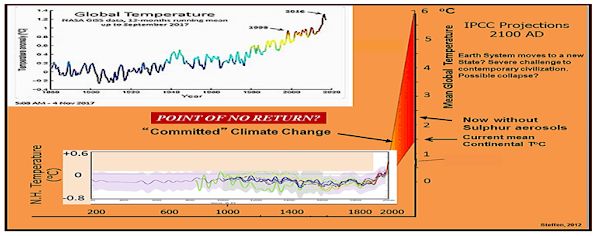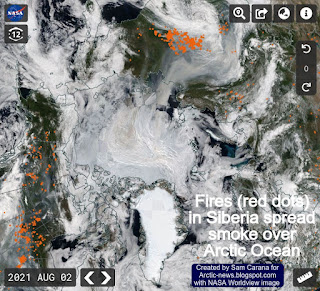Earlier forecasts warned about even higher anomalies over the Arctic, as illustrated by the image below.
An influx of warm, salty water into the Arctic Ocean can penetrate sediments at the seafloor of the Arctic Ocean that contain vast amounts of methane in the form of methane hydrates and free gas underneath such hydrates. Greater salinity and higher temperatures can cause such hydrates to destabilize, resulting in eruptions of huge amounts of methane and in rapid global warming.
- a stronger-than-expected El Niño would contribute to
- early demise of the Arctic sea ice, i.e. latent heat tipping point +
- associated loss of sea ice albedo,
- destabilization of seafloor methane hydrates, causing eruption of vast amounts of methane that further speed up Arctic warming and cause
- terrestrial permafrost to melt as well, resulting in even more emissions,
- while the Jet Stream gets even more deformed, resulting in more extreme weather events
- causing forest fires, at first in Siberia and Canada and
- eventually also in the peat fields and tropical rain forests of the Amazon, in Africa and South-east Asia, resulting in
- rapid melting on the Himalayas, temporarily causing huge flooding,
- followed by drought, famine, heat waves and mass starvation, and
- collapse of the Greenland Ice Sheet.
 |
| [ image from earlier post, click on images to enlarge ] |
 |
| [ click on images to enlarge ] |
 |
| [ from an earlier post ] |
The image below, from an earlier post and adapted from ECMWF, shows the ENSO anomalies and forecasts for developments through November 2026 in Niño3.4 (left panel) and in Niño1+2 (right panel), indicating that the next El Niño will emerge and strengthen in the course of 2026.
The danger is that a Double Blue Ocean Event will occur in 2026, i.e. sea ice approaching a low of one million km² both for Antarctic sea ice and Arctic sea ice.
An Antarctic Blue Ocean Event in February 2026 in turn would threaten to trigger an Arctic Blue Ocean Event later in 2026.
Ominously, Arctic sea ice extent was 11.19 million km² on December 22, 2025, a record low for the time of year. What makes this record daily low even more significant is that it was reached without El Niño conditions elevating temperatures.
 |
| [ screenshot from earlier post ] |
UN secretary-general António Guterres recently spoke about the need for “a credible global response plan to get us on track” regarding the international goal of limiting the global temperature rise. “The science demands action, the law commands it,” Guterres said, in reference to a recent international court of justice ruling. “The economics compel it and people are calling for it.”
What could be added is that the situation is dire and unacceptably dangerous, and the precautionary principle necessitates rapid, comprehensive and effective action to reduce the damage and to improve the outlook, where needed in combination with a Climate Emergency Declaration, as described in posts such as this 2022 post and this one and as discussed in the Climate Plan group.
Links
https://ads.nipr.ac.jp/vishop
• Extreme weather
https://arctic-news.blogspot.com/p/extreme-weather.html
• Cold freshwater lid on North Atlantic
https://arctic-news.blogspot.com/p/cold-freshwater-lid-on-north-atlantic.html
https://ocean.dmi.dk/arctic/icethickness/thk.uk.php
• Kevin Pluck - Sea ice visuals
https://seaice.visuals.earth
• Ocean submesoscales as drivers of submarine melting within Antarctic ice cavities - by Mattia Poinelli et al.
https://www.nature.com/articles/s41561-025-01831-z
Also discussed on Facebook at:
https://www.facebook.com/groups/arcticnews/posts/10163636947369679
• Climate Reanalyzer
https://climatereanalyzer.org
• University of Bremen
• The threat of seafloor methane eruptions
https://arctic-news.blogspot.com/2025/11/the-threat-of-seafloor-methane-eruptions.html
• Feedbacks in the Arctic
https://arctic-news.blogspot.com/p/feedbacks.html
• NOAA - Global Monitoring Laboratory - Data Visualisation - flask and station methane measurements
https://gml.noaa.gov/dv/iadv
• Focus on Antarctica
https://arctic-news.blogspot.com/2025/09/focus-on-antarctica.html
• Transforming Society
https://arctic-news.blogspot.com/2022/10/transforming-society.html
• Climate Plan
https://arctic-news.blogspot.com/p/climateplan.html
• Climate Emergency Declaration
https://arctic-news.blogspot.com/p/climate-emergency-declaration.html

















































